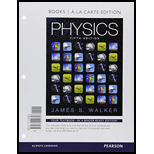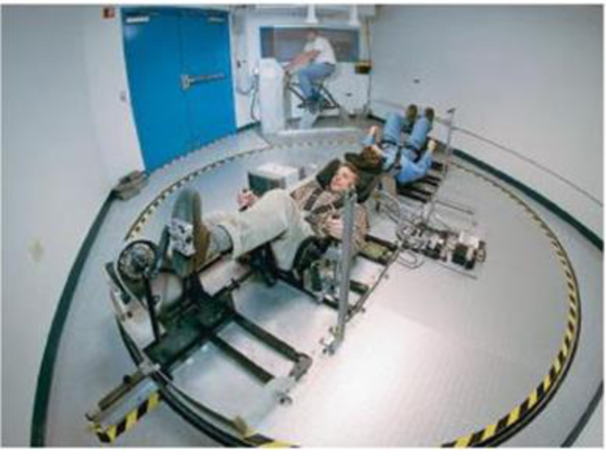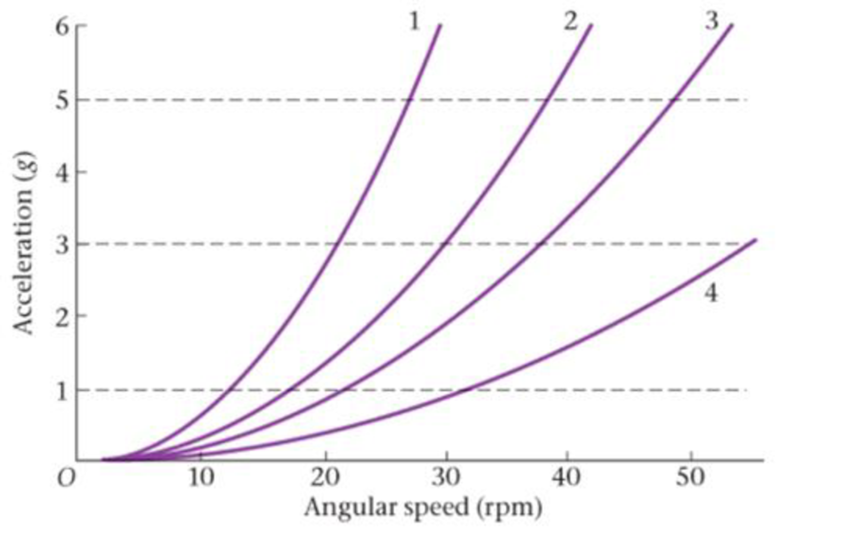
Concept explainers
BIO Human-Powered Centrifuge
Space travel is fraught with hazards, not the least of which are the many side effects of prolonged weightlessness, including weakened muscles, bone loss, decreased coordination, and unsteady balance. If you are fortunate enough to go on a trip to Mars, which could take more than a year each way, you might be a bit “weak in the knees” by the time you arrive. This could lead to problems when you try to take your first “small step” on the surface.
To counteract these effects, NASA is looking into ways to provide astronauts with “portable gravity” on long space flights One method under consideration is the human-powered centrifuge, which not only subjects the astronauts to artificial gravity, but also gives them aerobic exercise. The device is basically a rotating, circular platform on which two astronauts lie supine along a diameter, head-to-head at the center, with their feet at opposite rims, as shown in the accompanying photo. The radius of the platform in this test model is 6.25 ft. As one astronaut pedals to rotate the platform, the astronaut facing the other direction can exercise in the artificial gravity. Alternatively, a third astronaut on a stationary bicycle can provide the rotation for the other two. While the astronauts’ feet are at the outer rim of the platform, their heads are near the center of the platform, and their hearts are 4.50 feet from the rim, which means that different parts of the astronauts’ bodies will experience different “gravitational” accelerations.

Human-powered centrifuge.
Figure 10-43 shows the centripetal acceleration (in g) produced by a rotating platform at four different radii. Notice that the acceleration increases as the square of the angular speed. Also indicated in Figure 10-43 are acceleration levels corresponding to 1, 3, and 5 gs. It is thought that enhanced gravitational effects may be desirable because the astronauts will experience the artificial gravity for only relatively brief periods of time during the flight.

Figure 10-43
Problems 94, 95, 96, and 97
96. • If the acceleration is 2.00g at the feet, what is the acceleration at the heart?
- A. 0
- B. 0.560g
- C. 1.40g
- D. 2.00g
Want to see the full answer?
Check out a sample textbook solution
Chapter 10 Solutions
Physics, Books a la Carte Plus Mastering Physics with Pearson eText -- Access Card Package (5th Edition)
Additional Science Textbook Solutions
Cosmic Perspective Fundamentals
Chemistry (7th Edition)
Microbiology: An Introduction
Campbell Biology (11th Edition)
Anatomy & Physiology (6th Edition)
Chemistry: An Introduction to General, Organic, and Biological Chemistry (13th Edition)
- Show that the units 1 v2/Q = 1 W, as implied by the equation P = V²/R. Starting with the equation P = V²/R, we can get an expression for a watt in terms of voltage and resistance. The units for voltage, V, are equivalent to [? v2 v2 A, are equivalent to J/C ✓ X . Therefore, 1 = 1 = 1 A V1 J/s Ω V-A X = 1 W. . The units for resistance, Q, are equivalent to ? The units for current,arrow_forwardPlease solve and answer the question correctly please. Thank you!!arrow_forwardPlease solve and answer the question correctly please. Thank you!!arrow_forward
- According to the provided information answer the question accorrding to grade 11 physics Jerry has decided to give up his part-time job for a new career, cat-burglar! Jerry loves the idea of dressing up like a cat all day and of course the chance of meeting Cat Woman! On Jerry's first "job" he figures out his escape plan. He travels 3.0 km south for 15 minutes and then 8.0 km west for 1.5 hours before reaching his house. Draw a sketch diagram of the path he took with all the appropriate labels.arrow_forwardPlease solve and answer all parts of the question correctly please. Thank you!!arrow_forwardPlease solve and answer this question correctly please. Thank you!!arrow_forward
 Physics for Scientists and Engineers: Foundations...PhysicsISBN:9781133939146Author:Katz, Debora M.Publisher:Cengage Learning
Physics for Scientists and Engineers: Foundations...PhysicsISBN:9781133939146Author:Katz, Debora M.Publisher:Cengage Learning Principles of Physics: A Calculus-Based TextPhysicsISBN:9781133104261Author:Raymond A. Serway, John W. JewettPublisher:Cengage Learning
Principles of Physics: A Calculus-Based TextPhysicsISBN:9781133104261Author:Raymond A. Serway, John W. JewettPublisher:Cengage Learning Physics for Scientists and Engineers, Technology ...PhysicsISBN:9781305116399Author:Raymond A. Serway, John W. JewettPublisher:Cengage Learning
Physics for Scientists and Engineers, Technology ...PhysicsISBN:9781305116399Author:Raymond A. Serway, John W. JewettPublisher:Cengage Learning Classical Dynamics of Particles and SystemsPhysicsISBN:9780534408961Author:Stephen T. Thornton, Jerry B. MarionPublisher:Cengage Learning
Classical Dynamics of Particles and SystemsPhysicsISBN:9780534408961Author:Stephen T. Thornton, Jerry B. MarionPublisher:Cengage Learning College PhysicsPhysicsISBN:9781285737027Author:Raymond A. Serway, Chris VuillePublisher:Cengage Learning
College PhysicsPhysicsISBN:9781285737027Author:Raymond A. Serway, Chris VuillePublisher:Cengage Learning Physics for Scientists and Engineers with Modern ...PhysicsISBN:9781337553292Author:Raymond A. Serway, John W. JewettPublisher:Cengage Learning
Physics for Scientists and Engineers with Modern ...PhysicsISBN:9781337553292Author:Raymond A. Serway, John W. JewettPublisher:Cengage Learning





